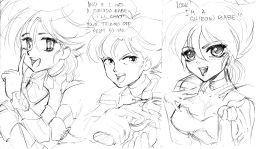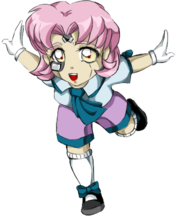Anime and manga
Apart from the intro and outro sequences, there has been no anime about Oni. The anime directly mentioned by the game's developers as influences on Oni include Ghost in the Shell (project lead), Bubblegum Crisis and Trigun (concept artist), and Neon Genesis Evangelion (design lead), and these are all very much worth watching.
There is no official manga or anime about Oni besides the opening/ending movies. There is art by Lorraine though, and the Dark Horse comic books.
- See the "Anime and Manga" portal on Wikipedia for general information about manga and anime. The following introduction was adapted from that portal.
|

The characteristic visual style shared by anime and manga can be called "anime" or "manga" depending on the context. Apart from the general characteristic, there is a variety of styles highly characteristic of "schools" or individual artists. There are also categories based on the targeted audience, and general archetypes (e.g., Shina-chan up there is a generic example of the chibi style).
The main influence for Oni was the manga/anime franchise Ghost in the Shell, so the game's concept artist Alex Okita came up with some character/environment design, largely anime-inspired, but drawing from not just GitS but other manga/anime that he admired (mentioned in the lede). The intro and outro sequences were based off Okita's storyboards by an actual anime studio called AIC. (AIC is mostly now defunct, only occasionally reactivating in order to animate small projects for the Japanese industry.)
Later on, Lorraine Reyes joined the team, contributing art in the form of splashscreens, promotional art, etc. and essentially setting a canonical style for Oni's 2D art. The Dark Horse "Oni" comics also borrow heavily (and clumsily) from the look of manga, but Lorraine's work is more skilled, and more authoritative among Oni's fan artists. Of course, these artists typically diverge from Lorraine's legacy using their own imagination and style.
On another note, Oni's 3D content (character models) is not particularly close to anime/manga guidelines; this is never an easy thing because of how anime and especially manga use "cheats" for depicting characters from different angles which don't align to a single 3-dimensional "truth".
Similar works to Oni
These works can be considered as added value for Oni's universe, and possible influences for an Oni 2 (whatever that is).
- Nausicaä of the Valley of the Wind (many aspects)
- Ergo Proxy (many aspects)
- Ghost in the Shell (duh)
- Appleseed
- GUNNM a.k.a. Battle Angel Alita
- Knives Millions from Trigun (sorta Muro)
- Kill Bill (killing philosophy)
- Full Metal Panic! (Melissa Mao)
